Imagine your website, which you’ve meticulously built over time, suddenly drops in rank on search engine results pages (SERPs). Even worse, what if it disappears from Google’s search results like it never existed? The thought is terrifying, isn’t it?
Well, such is the power of a Google penalty. But here’s the good news: this is a fixable situation! And that’s exactly what we’ll explore in this article. This comprehensive guide will set you on the path to recovering from any type of Google penalty.
Introduction to Google Penalty Recovery
Google penalty recovery involves identifying whether your website has been hit by a manual or algorithmic penalty issued by Google for violating its Webmaster Guidelines. The recovery process requires fixing the issues that caused the penalty, such as removing spammy backlinks or improving low-quality content, and then submitting a reconsideration request to Google if it’s a manual penalty. For algorithmic penalties, improvements must be made in accordance with Google’s guidelines, and the site must wait for Google to re-crawl and re-index the changes, which can vary in time from a few days to several months
A Google penalty dramatically impacts website traffic by pushing down site rankings or completely removing the website from search listings. The consequences are often drastic, with reduced visibility leading to less organic traffic, denting lead generation, and e-commerce sales.
The longer you take to address and recover from a penalty, the more likely your business is to sustain damage due to shrinking online visibility. However, reclaiming lost ground becomes entirely possible with the proper steps taken at the right time and consistent effort.
Types of Google penalties and how they affect websites
Let’s examine the types of penalties Google imposes and how they impact websites. Two primary types often haunt search engine optimization (SEO) enthusiasts: manual penalties and algorithmic penalties.
Manual Penalties vs. Algorithmic Penalties
Manual penalties are human-reviewed infractions, meaning an actual person at Google has scrutinized your website and found that it did not adhere to the search engine’s Webmaster Guidelines. Often, Google sends a note via Search Console notifying you about this issue with steps for rectification.
Conversely, algorithmic penalties occur when an automatic filter built into Google’s various algorithms spots a violation. Unlike manual sanctions, where you receive explicit notifications of infringements, these activities remain hidden until you see drastic drops in rankings and organic traffic.
The task, then, is knowing which type of penalty has hit your site. This distinction is crucial when formulating an effective recovery strategy, meaning that you’ll need to understand how you ended up penalized in the first place.
Common reasons for Google penalties
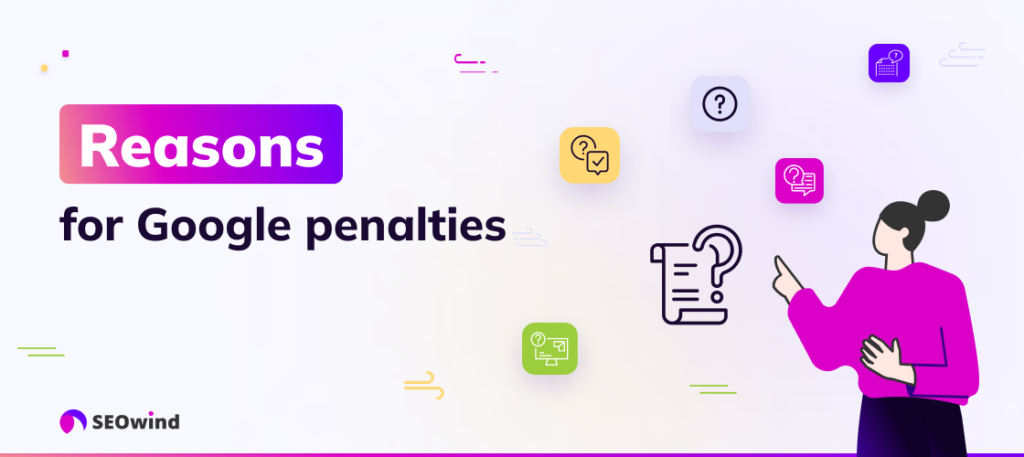
So, why do these penalties occur in the first place?
In my experience, several common reasons typically lead to this point:
- Slow Site Speed: As stated earlier, Google emphasizes site speed. A slow website failing to load information within seconds will negatively affect user experiences, which Google wants to prevent.
- Low-Quality Content: Presentation matters, and so does substance! If your content lacks useful information or, worse still, engages in poor copying tactics, be ready for trouble!
- Keyword Stuffing: Excessive keyword use disrupts the natural flow of written material, making it difficult for users to engage with your content. As a result, Google frowns upon such tactics.
- Unnatural Backlinks: These are often characterized by links from spammy or unrelated websites and paid links without no-follow designation. All of these are accountable for a sudden spike in backlinks, which is a big red flag for Google!
What’s important here is that these Google penalties are not permanent marks of doom. You can recover with a concerted effort! But you have to know what to look for and how to react.
Detecting a Google penalty on your website
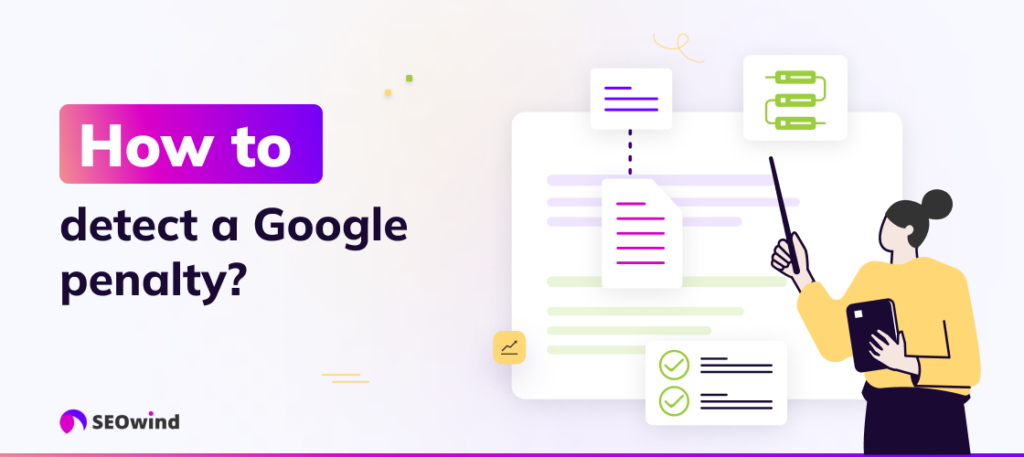
Once you understand the concept of a Google penalty and why it occurs, the next step is figuring out how to detect if your website has suffered such an unfortunate setback. This process can be broken down into two parts: recognizing the signs and using specialty tools.
Signs of a Google Penalty
The first undeniable clue that signals a Google penalty is a noticeable drop in your search engine rankings or organic traffic. If previously high-ranking keywords perform worse than expected, there’s cause for concern.
Another signal could be receiving an official notification on your Google Search Console account. This most likely indicates that manual action has been applied to your site. Don’t panic right away! But you need to take swift action to rectify whatever issues have been highlighted.
Now, let’s discuss some subtle signs. For instance, if specific pages from your site are no longer indexed or they have become hard to locate even with exact keyword matching, you might have received an algorithmic penalty.
Tools for Identifying Google Penalties
Sometimes, gauging organic traffic or rankings changes does not yield clear results. In such instances, certain tools help perform the Google penalty check.
One such tool is Google Analytics, which helps monitor any sudden dips in traffic that could hint at penalties. Additionally, Semrush Sensor can assist with identifying fluctuations linked to new updates from Google algorithms.
Similarly, useful resources like Fruition’s Google Penalty Checker and FE International’s Website Penalty Indicator help forecast how diverse algorithm updates impact various industries differently.
Another helpful option to consider is the coveted Google Search Console (previously Webmasters). In addition to receiving official notifications about penalties, this tool provides tips on overall SEO health checks, index status, and so forth.
Remember, swiftly detecting a penalty is just the beginning of your recovery journey. Understanding its root cause is crucial for developing a comprehensive recovery strategy. So, stay perceptive of these signs and use these potent tools when in doubt.
Steps to recover from a Google penalty
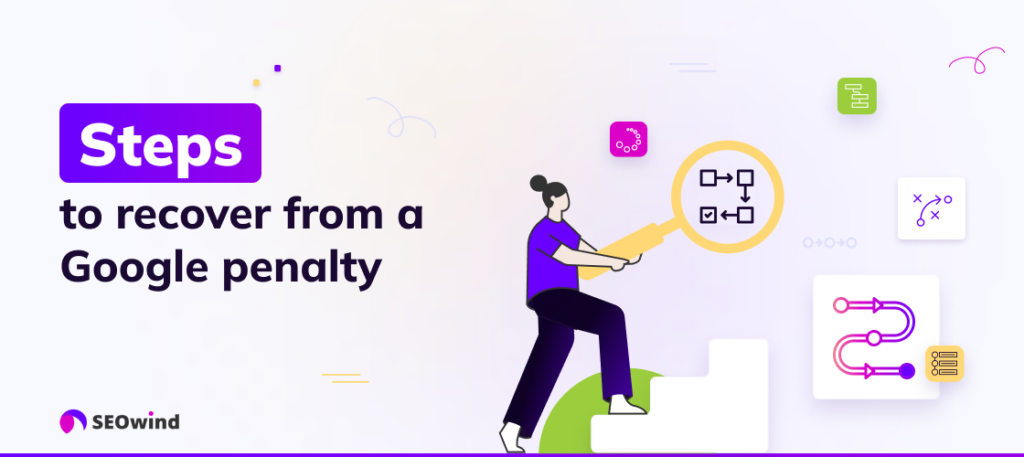
No one imagines finding themselves in the unwelcome grip of a Google penalty. But when it does happen, don’t despair! Fixing it is possible, and here’s a step-by-step strategy that I recommend. It’s time to start your Google penalty recovery mission.
Assess the Extent of the Penalty
Your first tactical move involves understanding how deep you’re buried under this issue. Not all penalties have equal severity, and knowing yours can shape your recovery plan.
To achieve this, take note of any messages from Google in your Search Console account. These alerts often outline which policy was violated, showing how severe the misconduct was. Manual penalties are usually more explicit than algorithmic sanctions. Also, monitor your site’s traffic trends over certain periods; sudden plummets might indicate if recent changes caused penalties or if older issues are bubbling to the surface.
Another method is checking keyword rankings, which is simple but effective. If specific keywords declined in performance, targeted pages may have incurred Google’s wrath.
Conduct a Comprehensive SEO Audit
Now you know what you’re up against, but you still need more intel, such as data about your website’s structure, indexability, navigation, content quality and quantity, and overall trustworthiness from an SEO perspective.
A detailed SEO audit helps to pinpoint where things went off track:
- Uncover technical constraints like broken links or server errors that impede users—both human and bots—from accessing content.
- Discover mishaps with robots.txt files or meta tags causing accidental de-indexation.
- Review backlinks for potential toxic associations dragging down site authority.
These will contribute to establishing a solid improvement plan that can be monitored over time.
Clean Up Backlink Profiles and Outbound Links
In the cleanup phase, we focus on rearranging or outright removing harmful elements. The inbound and outbound backlink profile demands immediate attention due to its heavy influence on your site’s reputation.
This involves sorting your backlinks into high-quality connections you’d like to foster and low-quality ones you want to disassociate from. Next, use Google’s Disavow Tool, which helps communicate to Google that certain links pointing to your website should not be considered in assessing link schemes.
Also, review the links leading from your site and ensure they take users to safe, relevant destinations related to your topic.
Fix Structured Data Issues
Organizing content is vital for SERP visibility. Rich snippets or Knowledge Graph Cards are enticing visual data points that users see directly on the search results page. However, errors here cause discrepancies between what’s displayed and the intended messaging, which can accrue penalties due to misleading structured data policies.
Tools such as Google’s Rich Results Test can detect issues with structured data syntax and vocabulary. Once highlighted, correct these flaws to improve user engagement, brand trust, and CTRs.
Address Content Quality and Relevance
Google appreciates websites that deliver value, meaning that stellar content is a winning bet. Aligning your content with user intent builds credibility over time, leading to more organic traffic while reducing the chances of future penalties.
To rejuvenate your content:
- Review existing material: Eliminate low-quality content or duplicate text that could be deemed ‘unhelpful’ by Google.
- Optimize extensively: Consistently deliver accurate metadata like title tags and descriptions to attract click-worthy interest.
- Attract with Originality: Provide fresh takes on topics within your niche to keep your audience engaged and returning.
You can kickstart the process by following these steps, knowing recovery is possible! This is not an overnight job, but dedicating proper effort will steadily help you regain lost ground while comfortingly avoiding repeat mistakes.
There’s always light at the end of every tunnel, no matter how deep or narrow it might seem. Acceptance is the beginning of your recovery journey!
Timeframe for Google penalty recovery
The time needed to recover from a Google penalty varies. Recovering your search rankings isn’t an instant process; it takes time and patience. This wait can feel interminable, primarily if your business heavily relies on organic traffic.
Factors Affecting Recovery Time
Several factors can influence the amount of time it will take to recover from a Google penalty:
- Type of Penalty: Whether the penalty is manual or algorithmic is significant in determining recovery time. Manual penalties tend to resolve more quickly once corrective actions are implemented, while algorithmic penalties often require more comprehensive changes, which might take longer.
- Severity of Offense: The severity of the violation committed also has a bearing on your site’s recovery timeframe. More serious breaches, such as cloaking or backlink spam, often lead to heavier penalties and, consequently, lengthier recovery periods.
- Response Time and Speed Of Rectification: How prompt you are in identifying the issue, taking corrective measures, and filing a reconsideration request affects the recovery period, too.
Keep in mind that even if you manage to remove a penalty, regaining your rank could still take several months or even years.
Best Practices for Accelerating Recovery
While patiently dealing with the aftermath of a Google penalty can be frustratingly slow-paced, adhering to certain best practices may help speed up the recovery process:
- Prompt Action: By acting swiftly upon receiving notification about a website violation, you’re already on track to faster recovery.
- Conduct a Comprehensive Audit: Ensure that every aspect of your website complies with Google guidelines by performing an exhaustive SEO audit.
- Monitor Your Website Regularly: Using analytics tools like Google Analytics, periodically monitor essential metrics like inbound links and content quality. Unusual shifts in these metrics often predetermine penalties.
- Use Google Webmaster Tools: Regularly review and address issues flagged by Google Search Console to prevent potential infringements preemptively.
A quick response, consistent monitoring of key website aspects, leveraging available tools, and staying informed can help accelerate your journey to recovery.
Proactive strategies to avoid future Google penalties
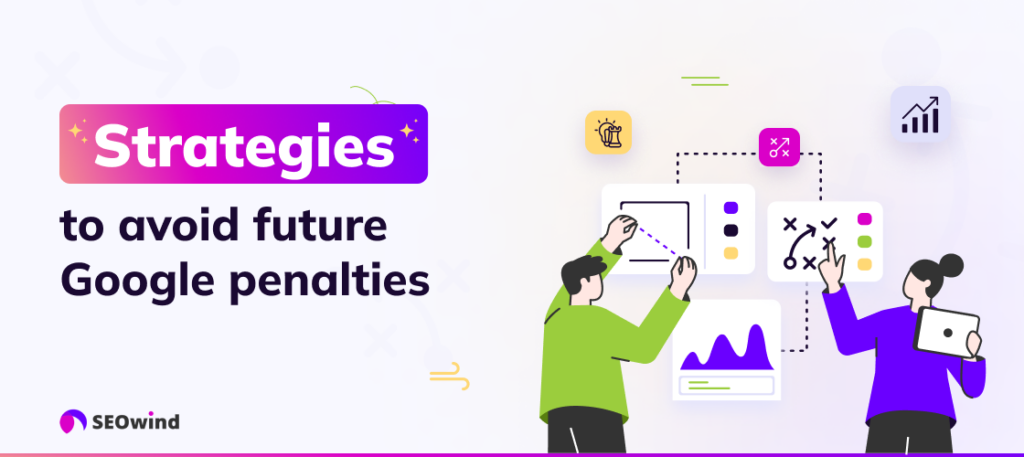
With the digital landscape continuously evolving, it’s crucial that you understand how to avoid Google penalties entirely. Prevention is always better than any cure. So, let’s cover some top-notch strategies that you can employ to avoid this challenge!
Staying Informed About Algorithm Updates
Being informed about algorithm updates is the bedrock of any effort to avoid future Google penalties. Google routinely rolls out updates that shift the tectonic plates underpinning search engine ranking factors.
- Make it a habit to follow reputable SEO news sites like Search Engine Journal, Search Engine Land, and Moz Blog; these platforms provide timely information on algorithm changes.
- Stay active in SEO communities or forums where professionals share their experiences and insights related to current trends.
Tracking algorithm changes as they happen will help you make necessary SEO strategy adjustments promptly. Ultimately, this practice will safeguard your site against potential penalties.
Regular Monitoring and Maintenance Practices
Just as frequent medical check-ups can prevent dire health issues, regular website monitoring is crucial for maintaining search engine rankings. Here are several vital tasks for doing so successfully:
- Monitor your website’s performance metrics using tools such as Google Analytics.
- Run audits using SEO audit tools to uncover any red flags before they become major issues.
- Keep a keen eye on your website’s backlink profile with expert tools such as Ahrefs and SEMRush.
These practices minimize problems like bad links or content issues, which could spark algorithmic or manual penalties.
Publish Helpful Content
Whether it’s 1998 or 2024, one principle remains constant: content is king. The caliber and relevancy of webpage content continue to be predominant factors that shape its influence online.
To duck pesky Google penalties:
- Focus on offering value-adding content that genuinely assists readers.
- Avoid keyword stuffing, duplicate content, or clickbait strategies.
- Keep your content fresh and up-to-date.
Creating top-tier content that caters to users’ interests compels Google’s algorithm to rank your site favorably while insulating you from penalties.
Write AI Content with the Right Tools and Processes
AI has penetrated virtually every domain, including SEO and content creation. This technology offers revolutionary capabilities but can also attract Google penalties if misused. This is especially common for those who create auto-generated content without providing tangible value to readers.
To exploit AI successfully:
- Engage credible tools for AI-powered content creation cautiously; a perfect example is OpenAI’s GPT-4 technology.
- Blend AI inputs with human oversight to ensure logic and human touch remain in check within written pieces.
- Run curated content through plagiarism detection tools to guarantee your publications are unique.
Employing these proactive strategies will help keep Google penalties at bay and even potentially boost your website’s performance. Remember, success on this journey requires consistency, adaptability, and, most importantly, patience!
How can SEOwind help avoid the Google penalty in the future?
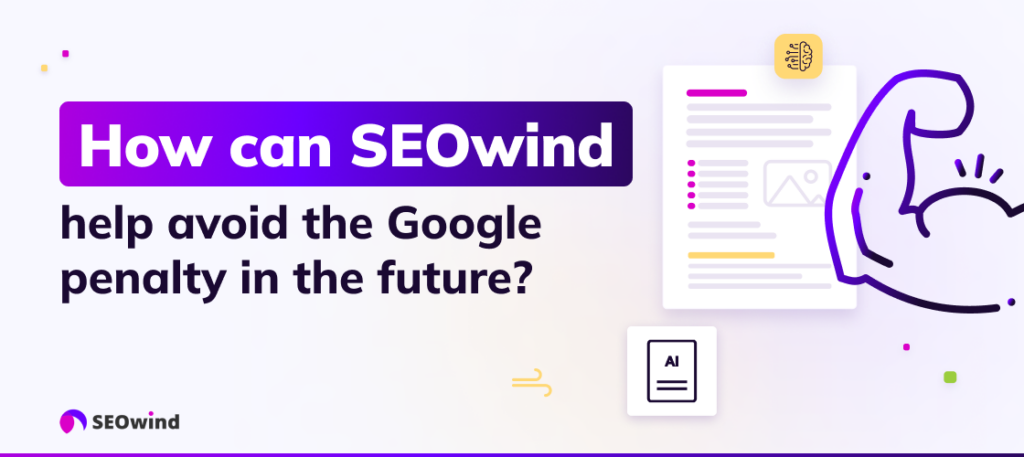
AI writing software like SEOwind can significantly keep your website in line with Google’s guidelines and avoid potential penalties. Here are some ways SEOwind helps you maintain an optimized, compliant web presence.
AI content that is based on research
Instead of just skimming the surface for content production, as many AI tools tend to do, SEOwind focuses on research. It assesses top-performing SERP data while considering keyword relevance and search intent analysis. It’s not just writing algorithmic articles; SEOwind sifts through substantial volumes of data to produce engaging content tailored to your target audience.
Our tool also addresses one of the leading causes of Google penalties: low-quality content. Its sophisticated AI technology allows for high-quality article creation, which positions your site as an industry authority and keeps penalty risks at bay.
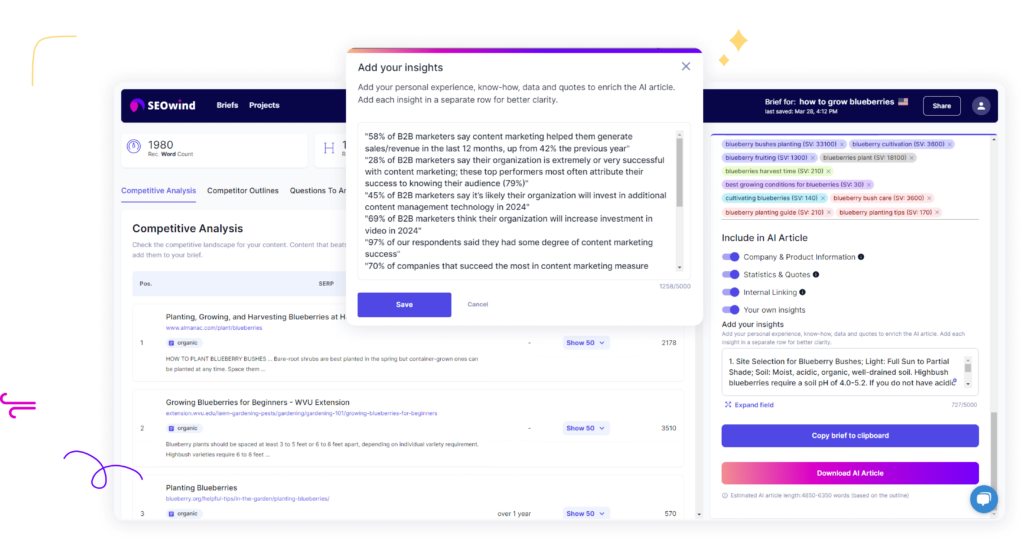
AI content enriched with stats and data
Google values well-researched content that provides real value to its users — and so does SEOwind. This tool enriches your AI content with accurate statistics and hard data points collected from reliable sources. This approach enhances credibility while building user trust, both of which Google factors into its algorithms.
AI content that is written with your brand voice
A distinctive brand voice plays a vital role in establishing your identity and building customer relationships. With SEOwind’s innovative prompting capabilities, every article fits your brand style, keeping your communication coherent.
This level of personalization goes beyond merely generating engagement. It further signals the authenticity of your web material, helping you avoid any Google penalties related to Plagiarism.
AI content with your custom insights
Not only does SEOwind automatically create personalized articles, but it also lets you insert insights specific to your niche into every piece of content. This allows your site to offer fresh and unique perspectives that stand out, thus fostering better SEO ranking potential.
The more distinctive your content is, the less likely you’ll be to attract punishment from Google due to duplicity or irrelevance.
AI content with internal links
Finally, AI truly shines when it comes to effectively reproducing internal linking. This is crucial for directing visitors around your website and encouraging them to engage more deeply with your material. In addition, it’s a key part of good SEO practice.
By using SEOwind’s AI capabilities for internal linking on your website, you can enrich the user experience and boost the whole website’s SEO structure. In doing so, you also ward off another potential source of Google penalties related to poor navigational practices.
SEOwind’s approach is built around one simple truth: producing high-quality content that fulfills user needs reduces the risk of Google penalties. With our tool by your side, maintaining the integrity of your web presence doesn’t need to be an uphill battle!

Ensuring long-term compliance and optimization efforts
The process of recovering from Google penalties might be demanding, but I hope that it now seems less daunting. With careful planning, it’s far from impossible!
If you are hit with a Google penalty, swift identification, and prompt corrective action are essential. You should evaluate the extent of the penalty, perform SEO audits, and improve backlinks, structured data issues, and content quality.
Rather than merely reacting when penalties occur, I recommend proactive efforts to ensure long-term compliance. Staying updated on algorithm changes will help you keep one step ahead. Regular website audits allow you to detect potential red flags before they result in penalties. And while AI tools can assist with content creation, don’t forget the human touch. Genuine value for readers goes beyond smooth syntax and high keyword density.
Your ultimate goal shouldn’t just be evading or recovering from Google penalties. Start by providing meaningful experiences to your users with quality content that respects Google’s guidelines. With the right mindset, you can shift your focus from mere survival after suffering a penalty to using authenticity and value to thrive!
Finally, don’t get discouraged if these steps seem overwhelming initially. Practice makes perfect. Keep working, and success will become inevitable.
The world of SEO can sometimes feel like a labyrinth, but with every challenge comes an opportunity for growth and expansion!
Google penalty recovery FAQs
While I’ve strived to offer detailed insights on Google penalties throughout this article, you might have some specific questions. Let’s dive into some common queries.
How Do I Remove a Google Penalty?
Removing a Google penalty involves identifying the cause, rectifying it, and requesting reconsideration from Google. Let me break it down for you:
- Identify the issue: First, familiarize yourself with why your site was penalized.
- Rectify the problem: This could range from improving poor content quality, removing harmful backlinks, or fixing any broken links on your site.
- Request Reconsideration: Once rectifications are made, file a reconsideration request using your Google Search Console account.
Keep in mind that this is just an overview. Each step has its ins and outs, which necessitates working methodically.
How Do I Resolve Google Penalties?
To resolve a Google penalty, follow these steps meticulously:
- Diagnose the root cause of your penalization. It may be due to spammy guest posts, unnatural backlinks, or low-quality content.
- Fix said problems according to their specifications.
- Submit a detailed document stating what violations existed on your website and how they were corrected via the Google search console.
Sincerity and transparency go a long way when dealing with Google’s support team.
What Happens When You Get A Google Penalty?
A swift drop in search rankings marks is one of the most common effects because a penalty typically means reduced visibility and potentially significant traffic loss for your site. This can become a dire situation if web traffic drives business growth for you!
Aside from tumbling rankings, other hallmarks include receiving an explicit message from Google in your Webmaster Tools account highlighting the detected issue(s) or, in the worst-case scenario, being completely de-indexed by Google!
How Long To Recover From Unhelpful Content?
The turnaround time for Google penalty recovery isn’t fixed. Instead, it’s contingent on several factors, including the severity of the issue, your response speed to address it, and Google’s review process, which can take a couple of weeks.
In the event of an unhelpful content penalty, the wait can extend from a few days to weeks. So, stay patient!


